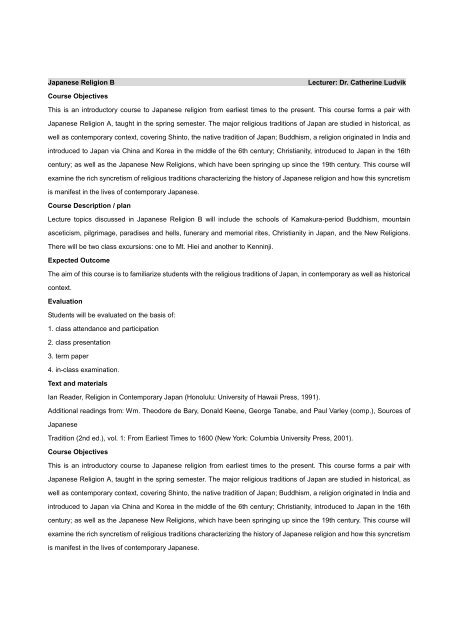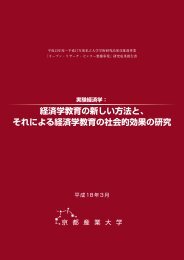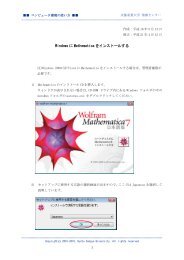GLOBAL JAPAN PROGRAM â Course Outlines (A â Spring ...
GLOBAL JAPAN PROGRAM â Course Outlines (A â Spring ...
GLOBAL JAPAN PROGRAM â Course Outlines (A â Spring ...
You also want an ePaper? Increase the reach of your titles
YUMPU automatically turns print PDFs into web optimized ePapers that Google loves.
Japanese Religion B<br />
Lecturer: Dr. Catherine Ludvik<br />
<strong>Course</strong> Objectives<br />
This is an introductory course to Japanese religion from earliest times to the present. This course forms a pair with<br />
Japanese Religion A, taught in the spring semester. The major religious traditions of Japan are studied in historical, as<br />
well as contemporary context, covering Shinto, the native tradition of Japan; Buddhism, a religion originated in India and<br />
introduced to Japan via China and Korea in the middle of the 6th century; Christianity, introduced to Japan in the 16th<br />
century; as well as the Japanese New Religions, which have been springing up since the 19th century. This course will<br />
examine the rich syncretism of religious traditions characterizing the history of Japanese religion and how this syncretism<br />
is manifest in the lives of contemporary Japanese.<br />
<strong>Course</strong> Description / plan<br />
Lecture topics discussed in Japanese Religion B will include the schools of Kamakura-period Buddhism, mountain<br />
asceticism, pilgrimage, paradises and hells, funerary and memorial rites, Christianity in Japan, and the New Religions.<br />
There will be two class excursions: one to Mt. Hiei and another to Kenninji.<br />
Expected Outcome<br />
The aim of this course is to familiarize students with the religious traditions of Japan, in contemporary as well as historical<br />
context.<br />
Evaluation<br />
Students will be evaluated on the basis of:<br />
1. class attendance and participation<br />
2. class presentation<br />
3. term paper<br />
4. in-class examination.<br />
Text and materials<br />
Ian Reader, Religion in Contemporary Japan (Honolulu: University of Hawaii Press, 1991).<br />
Additional readings from: Wm. Theodore de Bary, Donald Keene, George Tanabe, and Paul Varley (comp.), Sources of<br />
Japanese<br />
Tradition (2nd ed.), vol. 1: From Earliest Times to 1600 (New York: Columbia University Press, 2001).<br />
<strong>Course</strong> Objectives<br />
This is an introductory course to Japanese religion from earliest times to the present. This course forms a pair with<br />
Japanese Religion A, taught in the spring semester. The major religious traditions of Japan are studied in historical, as<br />
well as contemporary context, covering Shinto, the native tradition of Japan; Buddhism, a religion originated in India and<br />
introduced to Japan via China and Korea in the middle of the 6th century; Christianity, introduced to Japan in the 16th<br />
century; as well as the Japanese New Religions, which have been springing up since the 19th century. This course will<br />
examine the rich syncretism of religious traditions characterizing the history of Japanese religion and how this syncretism<br />
is manifest in the lives of contemporary Japanese.





![Katalog der Ausstellung [pdf, 5663.6k]](https://img.yumpu.com/47907208/1/184x260/katalog-der-ausstellung-pdf-56636k.jpg?quality=85)




